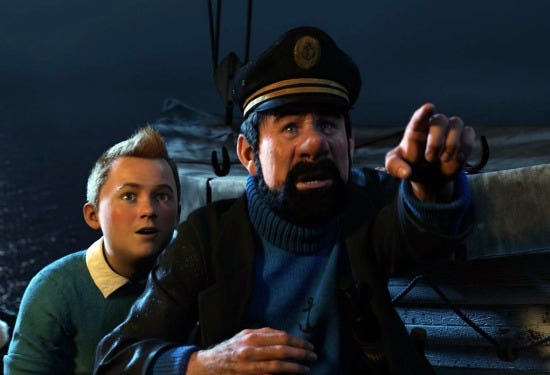The Adventures of Tintin

A crazy quilt of over-the-top action and cartoon wonders, "The Adventures of Tintin" is the first animated film by Steven Spielberg and hopefully not the last.
This giddy, fast-paced thrill ride defies gravity and logic as the titular character, a boy adventurer, and his pals get into one unbelievable scrape after another.
Spielberg employs 3D motion capture technology similar to what his contemporary, Robert Zemeckis, has used in his last three films (with results varying from the wonderful "The Polar Express" to the woeful "A Christmas Carol").
The animation is absolute terrific, hitting that sweet spot in between a near-photographic representation of reality and just enough cartoony distortion to keep things above the rim of the "uncanny valley." Peter Jackson, whose Weta studio handled the animations, is a producer and reportedly will direct the next "Tintin" movie with Spielberg producing.
(It is being released in 3D, and quite a good rendition of the much-overused cinematic trick it is, although Spielberg has a little too much fun pointing swords, canes and other objects at the audience for gasp moments.)
Tintin looks more or less like a normal boy except for a swoop of red hair that makes his forelock resemble a mini mohawk. The grown-ups tend to be just a little off, with oversized eyes or noses of dimensions rarely seen outside of clown college. Even though the textures are realistic — right down to the alcohol-induced crinkles around Captain Haddock's eyes — we never forget we're watching a cartoon.
The movie is based on the comic books by Hergé, mostly unknown here in the States but a big deal across the pond in Europe. Screenwriting trio Steven Moffat, Edgar Wright and Joe Cornish combine three of Hergé's stories into a freewheeling yarn that makes hardly a lick of sense but isn't meant to.
Jamie Bell voices Tintin, a self-described boy journalist who seems to lack a surname or parents. For that matter, he lives by himself in a small apartment with just his rapscallion dog Snowy and has his own money and a gun to boot.
Tintin's specialty is sleuthing out big crimes and then writing about them. (Though strangely, all the newspaper clips he has framed in his home are other papers about his latest triumph rather than the ones carrying his byline.) He combines an encyclopedic knowledge of history and culture with gumption and a whole lot of luck.
The end result is something like "The Da Vinci Code" meets "Raiders of the Lost Ark" meets the Hardy Boys.
Things get started when Tintin purchases an extravagant model of a 17th-century ship at an open-air market. Right on his heels is Ivanovich Sakharine (Daniel Craig), a peevish professorial type who wants the ship for himself. Before long, gunshots have been fired, the ship reveals a clue and it's off to the races.
Tintin's journey brings him to the ship of Haddock, a drunkard whose family traces its roots back to Sir Francis Haddock, heroic captain of the Unicorn, whose vast treasure was lost in a pirate attack by the notorious Red Rackham. Both Haddocks are voiced by Andy Serkis, and a marvelous vocal performance it is — such that one would never have guessed this was the same hidden performer behind Gollum and King Kong.
Haddock's a great character, a man of conviction who doubts his own courage. In fact, in the latter half of the movie he tends to dominate to such an extent that Tintin fades into the background.
The action setpieces are as marvelous as they are preposterous. There's one long chase through the streets and skies of the Arab town of Bagghar, with Tintin and Haddock pursuing a bird while being chased by a motorcycle, a tank and a hotel (yes, really). They fly through the air, tumble and fall, crash through windows and nobody ever suffers more damage than a few scrapes.
"The Adventures of Tintin" doesn't really add up to much more than a good time, but often it's a really, really good time.
4 Yaps



